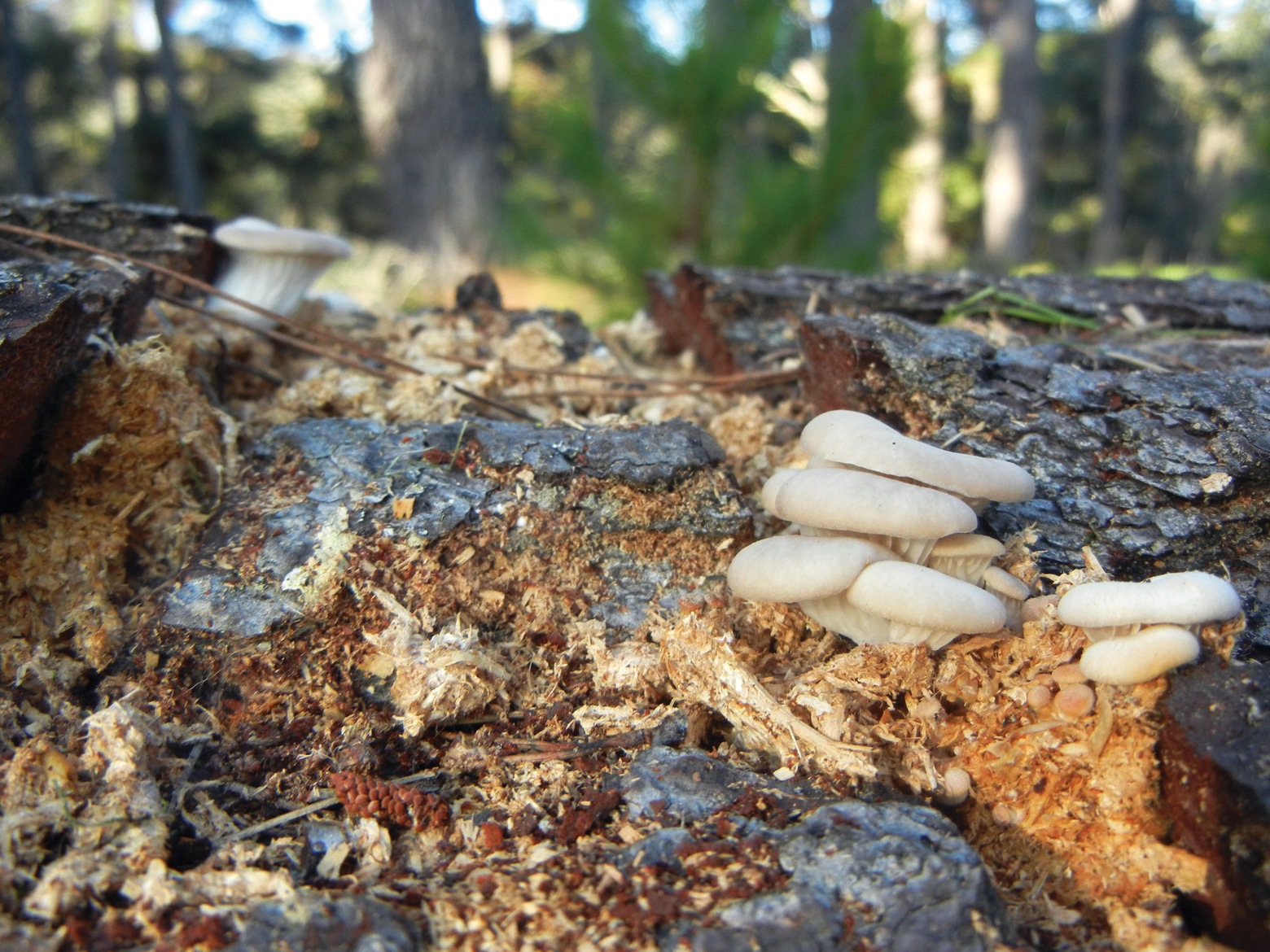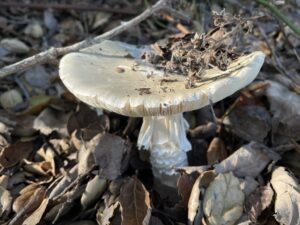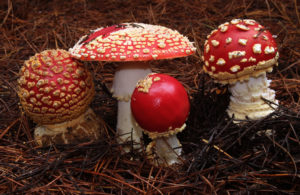In the glare of the bright sunshine flooding Duffel Meadow, a pale swath of cattle-trodden grassland near Orinda, several dozen lumpy burlap sacks lie gray and ragged, no more conspicuous than a pile of compost, in two natural swales. But each bag’s straw and wood chip stuffing is threaded with a rich web of mushroom mycelium that is doing some heroic work: quickly consuming any E. coli that pass through it.
These bags contain two types of fungi, King Stropharia and oyster, that can digest E. coli in a very short period of time—“we’re talking, like, an hour”—says Mino de Angelis, a Berkeley resident who’s leading this experimental project at Duffel Meadow. De Angelis prods at the parts of the damp bags that are shredding open, revealing a handful of harmless fruiting bodies—what we call “mushrooms.”
The oyster and Stropharia are absorbing harmful fecal microbes—like E. coli and Giardia from the cattle that regularly graze here—which can seep into the local watershed. That watershed, including Duffel Meadow, belongs to the East Bay Municipal Utility District (EBMUD) and drains into the utility’s San Pablo Reservoir. De Angelis is a volunteer, one of several dozen members of Bay Area Radical Mycology (BARM), a dedicated crew of mushroom enthusiasts who see promise in the fungus kingdom beyond taste and beauty. Their claim—one that’s becoming increasingly less radical, at least in the scientific community—is that fungi can not only recycle natural “waste” products in the forest, but can also recycle highly toxic human-generated waste, including petroleum, heavy metals, plastics, and pesticides. Recent studies have found, for instance, that certain fungi can remediate oil spills, decompose the cellulose in disposable baby diapers, and siphon the gold from ground-up cell phones.
“All this stuff is really new,” says de Angelis, who’s been a mushroom buff for some time and has seen interest in so-called “mycoremediation” take off in the last few years. “We know a heck of a lot more this year than we did the year before, but there’s still a lot more to find out.”
Maya Elson and Peter McCoy, two local mycophiles who wanted to do more than exchange morel-hunting secrets, formed Bay Area Radical Mycology about three years ago. So far, the group has been involved in a dozen workshops, remediation projects, and fungus fairs. Members meet monthly to brainstorm activity ideas (a “petri-dish party” to help build members’ lab skills, a “guerrilla gardening” excursion to toss “spore bombs” into neglected urban lots). “We’re not really interested in just talking about it,” says de Angelis, who, like most members, is self-taught and got involved largely out of concern for the environment. “We want to get out there and do something.”
They’ve found an eager partner in EBMUD. The E. coli filtration project, among several barm is working on with the agency, is more about practice and potential than it is about results; ebmud’s drinking water is treated downstream from Duffel, so any E. coli presence is not a health issue, and anyway, de Angelis says, “it’s such a vast watershed; what we’re doing right now is a drop in the bucket.” Instead, barm volunteers are using the partnership they’ve formed with ebmud as a sort of teaching lab for themselves, other volunteer groups, and ebmud staff. They’re basing the experiment on studies by renowned mycologist and fungus advocate Paul Stamets, and what they learn could provide a simple, eco-friendly tool for EBMUD and local landholders to tackle small-scale bacterial contamination.
EBMUD senior ranger and volunteer coordinator Virginia Northrop says there are some private stables near EBMUD land, for instance, that can generate “mountains of manure” that shed to creeks and then to reservoirs; an inexpensive biofiltering method like mycoremediation could easily be applied to some of those areas to reduce the burden on treatment facilities.

Another BARM–EBMUD project, one that tests mushrooms’ ability to speed up the process of wood decomposition, has had more immediate results. Near San Pablo Reservoir, ebmud workers have been gradually logging a forest of Monterey pines that are reaching the end of their normal life span and pose a potential fire risk. But the logging requires either hauling out the felled logs using diesel engines or letting them sit, increasing the chance of wildfire. Starting in November 2012, barm volunteers began “inoculating” the logs with various kinds of locally foraged fungi, including oyster, lion’s mane, false turkey tail, and artist’s conk. Once the fungi take hold, the logs are less likely to burn and more likely to decompose quickly, since mycelium retains moisture and breaks down the wood’s lignin, making a log spongier and less brittle. It’s a simple, commonsense project with potential to expand; the usda’s Natural Resource Conservation Service recently contacted barm to see if they could do similar work on a eucalyptus site in Pescadero.
“They’re doing really cutting-edge stuff,” says ebmud’s Northrop, adding that barm has been “our best volunteer group ever” thanks to its fount of enthusiasm. Paul Stamets has done fantastic work with mycoremediation, she says, “but we hadn’t seen much of it done in the East Bay—until these guys.”
And she wouldn’t mind seeing a lot more of it. Since a big part of Northrop’s job is managing the health of local ecosystems, from creeks to forests to hillsides, the more economical and ecological the methods, the better. “I’ve been in this field a long time, and to me this is something that should explode,” she says. “It’s so healthy for the forest; it’s so healthy for the land. Mushrooms are just this untapped resource.”




